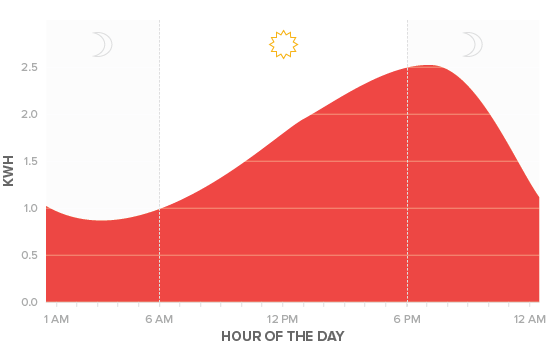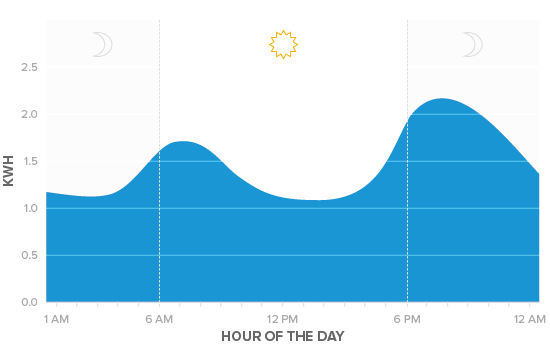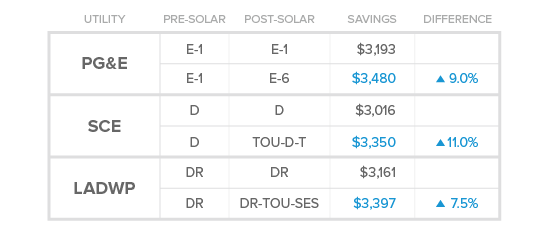Products
Smarter Savings Forecasts with Intelligent Baselining
By Kevin Timms
| Reading time 4 minutes
We’ve significantly upgraded the way homeowners’ electricity usage is baselined prior to going solar. Now it’s possible to accurately model savings and avoided cost for all customers including those on time of use tariffs with as few as one utility bill! Part of our recent set of upgrades to Switch, this new feature is called Intelligent Baselining.
What Happens Now?
Without Intelligent Baselining, savings forecasts require an entire year’s worth of bills. Having 12 months of usage captures how a household’s consumption changes across seasons. Knowing this variation is especially important for savings projections since approximately 52% of residential electricity rate plans in the U.S. have seasonally-dependent charges.
Even with a full year’s worth of bills, savings forecasts have largely been limited to non-Time-of-Use (non-TOU) tariffs. A monthly bill provides no meaningful information about electricity usage from one hour to the next, or one day to the next. Since electricity rates vary within a day on TOU tariffs, you cannot accurately predict savings without understanding hourly and daily usage. Ideally, you could base TOU savings projections on customers’ hourly meter data, but this data is not always available and otherwise presents a major bottleneck in the sales process.
Intelligent Baselining for Analyzing TOU
Genability’s tariff database indicates approximately 35% of residential rate structures in the U.S. currently have some rates that vary across days or within a day. In many markets, TOU rate plans are becoming increasingly popular. For example, around 41% of Arizona Public Service customers are on a TOU plan. Residential TOU tariffs are also expected to become more common for Pacific Gas & Electric (PG&E), Southern California Edison (SCE), and San Diego Gas & Electric (SDG&E) customers since the California Public Utilities Commission is mandating that a TOU rate structure be the default residential tariff within 5 years. This trend is expected to spread nationally in coming years, particularly as electric vehicles and smart home appliances become more popular. These products give homeowners more control over when they use electricity and therefore incentivize switching to rate plans where electricity is cheaper at certain times.
If a household’s meter data isn’t available, forecasting savings under TOU plans requires a better understanding of hourly consumption. Enter Intelligent Baselining. Intelligent Baselining interpolates hourly usage from a monthly bill based on how residential customers generally use electricity from one hour to the next, and from one day to the next. More specifically, this interpolation draws from Genability’s models of typical electricity use for every hour in a year. These models are specific to region and building type, and account for the effects of location, weather, and the behavior of different types of homeowners.
The figures below show Intelligent Baselining in action. The first plot shows the interpolated hourly usage over a summer day, for example an APS customer who uses 1,000 kWh of electricity a month.

Intelligent Baselining accounts for the fact that in summertime Arizona households typically use the most electricity during the afternoon and early evening. It’s hottest outside at these times and air conditioning is used most heavily. We see that Intelligent Baselining also accounts for the decreasing and lower usage that’s characteristic of homes in the cooler hours (i.e. overnight and early morning).
This following plot (blue) shows interpolated hourly usage for the same Intelligent Baselining customer in Arizona, but for a winter day.

Here we see that more electricity is used just before work and after work, which makes sense. Comparing the plots of summer vs. winter hourly usage, we see that the same Intelligent Baselining model accounts for intra-day energy variation, but also how that intra-day variation changes across seasons (particularly due to the use of air conditioning in this example).
With the interpolated hourly usage information we can better predict how much customers will be charged under TOU rate schedules. For example, we could more accurately forecast how much the customer in the example plots above will be charged on those two days if they are on the APS ET-1 tariff, where electricity is more expensive from 9:00 AM to 9:00 PM than it is overnight (9:00 PM to 9:00 AM).
Ultimately, the Intelligent Baselining feature of Genability’s Savings Analysis API will help you determine when switching to TOU rates is optimal for your solar customers. The following chart shows some examples of where Intelligent Baselining was used to find 7.5% - 11.0% more savings when a solar customer switches to a TOU plan.

Intelligent Baselining for Extrapolating Usage
Intelligent Baselining also helps streamline the sales process if a potential customer doesn’t have 12 bills on hand. It does this by automatically extrapolating an entire year’s worth of usage from as little as one bill. As with the interpolation capabilities of Intelligent Baselining, the extrapolation function is based on the models of typical yearly energy use specific to region and building type.
Early numbers indicate that on average, Intelligent Baselining can use just one bill to predict annual usage within approximately 15% of actual annual usage on average. Much more detail on the accuracy of this extrapolation is available to customers upon request and will be touched upon in a later blog post.
How Can I Use Intelligent Baselining?
If you want to use Intelligent Baselining to significantly simplify the sales process and improve savings predictions, it can be turned on and off in calls to the Savings Analysis API. More information for current customers on how to do this is found on our developer documentation site. For others who are as excited about Intelligent Baselining as we are, we’re happy to give you a tour of Genability’s suite of products, including a Switch demo. Contact sales to set up a demo today!
Also in Products
Switch Version 3 Now Available!
By Tarpan Dixit | Sep 17, 2015
Considering Solar? Check out OpenSavings.
By Ruben Garcia | Jun 9, 2015
Genability's Switch is the Market Standard for Residential Solar
By Eric Danziger | May 21, 2015
Developer Documentation How-Tos and Java Library
By Scott Harris | Apr 29, 2015

